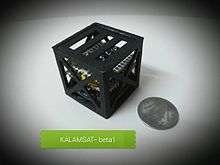Kalam SAT

Kalam SAT is a Femto Satellite and widely claimed to be the world's lightest satellite. It is named after former Indian president Dr. A. P. J. Abdul Kalam and was built by an Indian High school student team, led by Rifath Sharook, an 18-year-old from the Tamil Nadu town of Pallapatti. The high school team participated in Cubes in Space, a STEM-based education program by Idoodle Learning.Inc and NASA. As selected student competitors, the team won an opportunity to design experiments to be launched into space on a NASA rocket. Kalam SAT was launched by NASA along with several other experiments on Terrier Orion sounding rocket on 22 June 2017 from Wallops Island flight facility in Virginia.[1][2][3][4][5][6][7][8]
The weight of the probe is just 64 grams and it is fitted in a 3.8 centimeters cube. The probe is composed of 3-D printed reinforced carbon fiber polymer. Part of the components were supplied from India and other parts from abroad. The probe was launched by a sub-orbital spaceflight. The expected time span of the mission (post flight) is 240 minutes. The tiny probe will be operated only for less than 12 minutes to demonstrate the performance of 3-D printed carbon fiber in a micro-gravity environment of space.
Although Kalam SAT has been reported to be the world’s lightest satellite, the term 'lightest' applies more to the KickSat Sprite—which is considerably smaller, lighter, and actually flown in orbit. Due to a malfunction, KickSat Sprites never deployed from KickSat, so that KickSat 1 orbited the earth as a 5.5 Kilograms 3U CubeSat. The Sprites burned up inside KickSat during re-entry.[9][10] In its first deployment, KalamSat would be a technology demonstrator satellite since it won't reach orbit; it will fly a sub-orbital flight on a sounding rocket.
The probe was built by a team of 7 people led by Rifath Sharook, an 18-year-old student from Pallapatti,[11] Tamil Nadu, India, on behalf of a Research Organization based in Chennai, as a part of a ‘Cubes in Space’ competition. This contest was jointly organized by NASA and ‘I Doodle Learning’, which is a global education company. This was the first time that a space probe made by an Indian student, was launched by NASA.
Records
Kalam SAT is designated in the pages of Asia Book of Records, India Book of Records and Assist World Records, as holding the record title of "World's lightest and smallest satellite".[12][13][14]
See also
References
- ↑ "18-year-old from Tamil Nadu designs world's lightest satellite". Srinivas Laxman, The Times of India. May 15, 2017. Retrieved May 15, 2017.
- ↑ "World's Lightest Satellite invented by Indian teen Rifath Sharook to be launched by NASA on 21st June". Aishwarya Krishnan, india.com. May 15, 2017. Retrieved May 15, 2017.
- ↑ "Tamil Nadu boy designs world's 'smallest' satellite for NASA". The Economic Times. May 15, 2017. Retrieved May 15, 2017.
- ↑ "NASA to launch world's lightest satellite built by Chennai student on June 21". Daily News and Analysis. May 15, 2017. Retrieved May 15, 2017.
- ↑ "World's Smallest Satellite Created for NASA by 18-Year-Old Indian Teen". Rachel Jacoby Zoldan, Teen Vogue. May 15, 2017. Retrieved May 15, 2017.
- ↑ "Meet the Indian teen who has developed world's smallest satellite for Nasa". Business Standard. May 15, 2017. Retrieved May 16, 2017.
- ↑ "KalamSat: Indian teen Rifath Sharook builds world's lightest and smallest satellite". Nupur Jha, International Business Times. May 15, 2017. Retrieved May 16, 2017.
- ↑ "KalamSat - World's smallest satellite built by Indian teen to be launched by NASA on June 21". Zee News. May 15, 2017. Retrieved May 16, 2017.
- ↑ "Crowd-Funded Satellite May Fall from Space Before Unleashing Tiny 'Sprite' Armada". Space.com. Retrieved 2017-06-14.
- ↑ "KickSat Re-Entry". Spaceflight101. Retrieved 2017-06-14.
- ↑ Jaisankar, C. (12 May 2017). "Karur student's satellite model to soar high". The Hindu. Retrieved 21 May 2017.
- ↑ "World's lightest and smallest satellite — Rifath Sharook: all set to break global space record". Asia Book of Records. 19 May 2017. Retrieved 21 June 2017.
- ↑ "Proud moment for India — World's lightest and smallest satellite — Rifath Sharook: all set to break global space record". India Book of Records. May 2017. Retrieved 21 June 2017.
- ↑ "The world's lightest, smallest and 1st time fully 3D printed satellite — Kalam SAT". Assist World Records. 2017. Retrieved 2017-06-26.